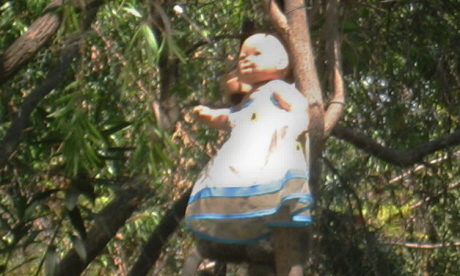
Thomas Rees uncovers a dark secret in the sleepy canal district of Mexico City and finds a culture fascinated by death and decay
It's hard to forget their eyes or the smiles that play around the corners of their mouths, gripped by plastic rigamortis. In spite of the heat, you feel yourself shiver.
The Island of the Dolls is as disturbing a sight as you'll find in Mexico City: more chilling than the Templo Mayor, where graphic stone friezes depict scenes of ritual blood-letting, or the Museum of Mexican Medicine with its collections of the skulls of syphilitic Aztecs.
A metro and a train ride away from the centre, the island is hidden among the canals of Xochimilco, in the city's tranquil suburbs. The name itself sounds like running water: Xochimilco, 'the place where the flowers grow'. It was once a great centre of agriculture, the 10th century home of the Xochimilca who built the network of waterways and floating gardens (chinampas) on the site of an ancient lake. Conquered by the Mexica Aztecs in the 14th century and razed by the Spanish just a few generations later, the town was swallowed by the urban sprawl of Mexico City in the 1900s.
Though the lake has all-but disappeared, many of the canals have survived and are popular with travellers and Mexican families seeking respite from the heat and the relentless pace of downtown. At weekends the languid waterways bustle with brightly painted trajineras, long wooden punts steered by thick-set Mexican pilots. Go with a group and haggle unashamedly and you can rent one for a modest sum. Pay a little extra and they'll take you to the dolls.
It was quiet when we arrived at the embarcadero on a week day afternoon, a group of eight from the hostel. We knew to avoid the landing stages closest to the train station where the price is hiked for tourists and to leave the talking to Daniel, a norteño from the state of Sinaloa. When it comes to bargaining, there's no substitute for being Mexican. The Argentinians who shared my dorm had learnt that to their cost, returning from Xochimilco the day before with pained expressions and empty pockets.
After several minutes of debate, punctuated by theatrical head-scratching and sharp intakes of breath, a deal was reached. Ramon, our pilot, motioned to a trajinera at the end of the row and we slid out onto the water. Broad-shouldered punts with decorative canopies slipped past, carrying wedding parties, marimba players and groups of mariachis who sweated beneath their sombreros and sequined jackets. They played requests as we dozed in the sunshine and stopped to buy pale yellow maize and bottles of beer from women in dugout canoes.
After an hour or so, the sound of trumpets and Mexican folk-songs drifted out of ear-shot. Ramon slowed the trajinera to a stop and steered us towards the bank, close enough to make out the bedraggled teddy-bears and broken toys that hung from the canopy. Balding dolls with lolling heads and twisted limbs of dull grey plastic returned our gaze. Their pastel pink dresses look like scraps of bunting, caught in the tired branches of the willow trees.
“They say that a girl drowned here years ago,” said Ramon, “that the dolls are possessed by her spirit.” His tale was fanciful but sinister all the same: a classic horror story about the island's lonely caretaker who found the girl's body and hung the dolls in the trees to appease her ghost. “He died in the same spot,” Ramon said, “some people think that the dolls killed him.”
It felt strange making our return, past flower gardens and summer houses, back to the embarcadero. Somehow the island is more unsettling for its sun-dappled location: a whisper of Mexico's morbid fascination in a place of sweetness and light. Even later that day, sat before plates of enchiladas in the noisy food-hall of Xochimilco's market, it played on our minds.